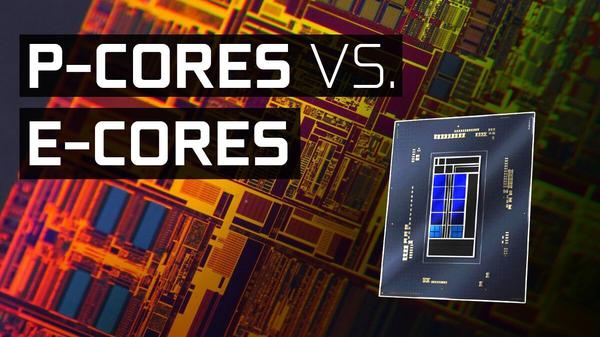The world of CPUs is undergoing a shift. Not only do we now have many CPU cores in our laptop and desktop PCs, but there’s also now a mix of different core types: the P- and E-cores are here.
Symmetrical vs. Asymmetrical CPU Design
In a traditional multi-core CPU, every CPU core is identical. They all have the same performance rating and use the same amount of power. The problem with this is that when your CPU is idling or doing simple tasks, there’s a minimum level of power usage you cannot drop below without switching the CPU off entirely. This isn’t the end of the world when it comes to devices that draw their power from the wall, but if you’re running on battery power, every watt counts!
RELATEDWhy Do CPU Cores All Have the Same Speed Instead of Different Ones?Smartphones quickly adopted a solution where you’d have some power-hungry cores that provided high-end performance and a number of efficient cores that sip power but perform well enough to run background system tasks or run basic applications such as email, social media, or web browsing.
The high-performance cores automatically kick in when you fire up a video game or in short bursts when a more basic app needs better performance to do a specific task, before falling back on the power-efficient cores.
Asymmetrical Design on PC
While the idea of having mixed CPU core types in a single package isn’t new,it’s not something that’s found in mainstream PCs. At least, that was true up to the release of Intel’s 12th-generation Alder Lake CPUs. These are Intel’s first mainstream CPUs to feature a mixture of different cores.
Advertisement
Within each model of 12th-generation Intel CPU, you’ll find E-cores (Efficiency) and P-cores (Performance) in the CPU package. The relative numbers between these two types of core can vary, but the full Alder Lake CPU die has eight P- and eight E- cores, which is found in the i9 CPU models. The i7 and i5 models have an 8/4 and 6/4 design for P- and E- cores respectively.
The Benefits of E- and P- Cores
There are many benefits to having this hybrid architecture approach in a CPU. Laptop users are going to benefit the most since the majority of daily tasks are not performance intensive. If all you need is the power of your E-cores, you’ll enjoy a cooler and quieter computer with longer battery life.
When you’ve got your laptop plugged into the wall or if you’re using a desktop computer, those E-cores are still important. Let’s say you’re playing a video game that needs all the CPU power you can throw at it. The game can have full access to all performance cores, while your E-cores take care of background processes and applications such as Slack, Skype, downloads, etc.
RELATEDCPU Basics: Multiple CPUs, Cores, and Hyper-Threading ExplainedIn the future, intensive applications that are written with hybrid CPUs in mind may even spawn threads that are assigned to both kinds of cores depending on their demands. E-cores are simpler and less expensive to produce, so using them to augment and free up cutting-edge performance cores is a smart idea.
In the case of Alder Lake CPUs at least, the P- and E- cores have been designed in such a way that they don’t interfere with each other so each can do their jobs independently.
AdvertisementUnfortunately, this radical shift in x86 CPU architecture isn’t happening without some teething troubles.
Early-Adopter Problems
Since mixing different CPUs is a relatively new thing for x86 CPUs, there are some rough edges to be aware of in the early days. Developers of PC software previously haven’t had reason to expect more than one type of CPU in a computer, so their software isn’t aware of the difference between a P- and E- core. In general, this isn’t an issue because the operating system assigns software threads to CPUs as needed, but there have been reports of some software (such as Denuvo) crashing or behaving strangely on these new CPU designs.
RELATEDHow to Upgrade Your PC to Windows 11Software patches as well as motherboard level legacy-mode workarounds are sure to come thick and fast. By the time you read this, the worst incompatibility issues may be resolved. If you’re a Windows 10 user looking to upgrade to one of these hybrid CPUs, you may want to either wait or go ahead and upgrade to Windows 11. At the time of writing in January 2022, Windows 11 has a new CPU task scheduler that’s aware of how to assign work to the different types of cores. While Windows 10 will work, it’s not doing so as well as it should and patches to bring it up to speed are still in the works.
How to Mind Your P’s and E’s
When you next buy a new CPU, there’s a good chance you’ll have to make a decision on how many P- and E-cores you want. The best advice we can give is to pay attention to the number of P-cores first and foremost. You need enough performance cores to run your most demanding application. Any additional overhead offered by the E-cores is a bonus.
We haven’t yet seen a situation where two CPUs have the same number of P-cores, but different numbers of E-cores. However, when that does become a reality it won’t be something to worry about until a new generation of hybrid-aware software becomes mainstream, and even then it will be a choice mainly aimed at laptop users. To sum it all up, here are the key facts you should know:
This is an exciting time for CPU technology and this hybrid generation of chips shows us that it’s not just ARM-based mobile CPUs, such as the Apple M1 products, that are experimenting with interesting ideas.
RELATED: What's the Difference Between Apple's M1, M1 Pro, and M1 Max?
READ NEXTSydney ButlerSydney Butler has over 20 years of experience as a freelance PC technician and system builder. He's worked for more than a decade in user education and spends his time explaining technology to professional, educational, and mainstream audiences. His interests include VR, PC, Mac, gaming, 3D printing, consumer electronics, the web, and privacy. He holds a Master of Arts degree in Research Psychology with a focus on Cyberpsychology in particular.
Read Full Bio »









